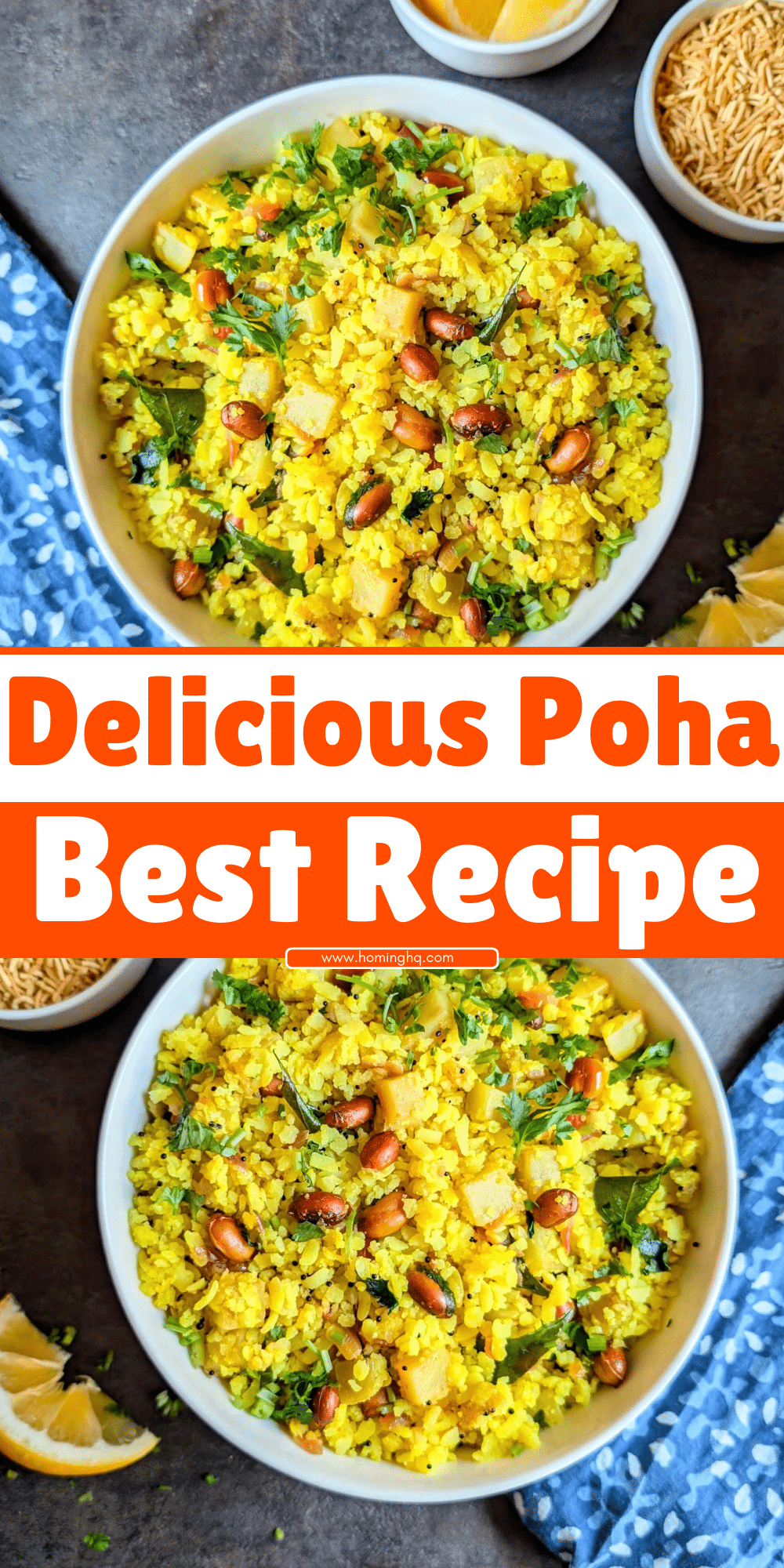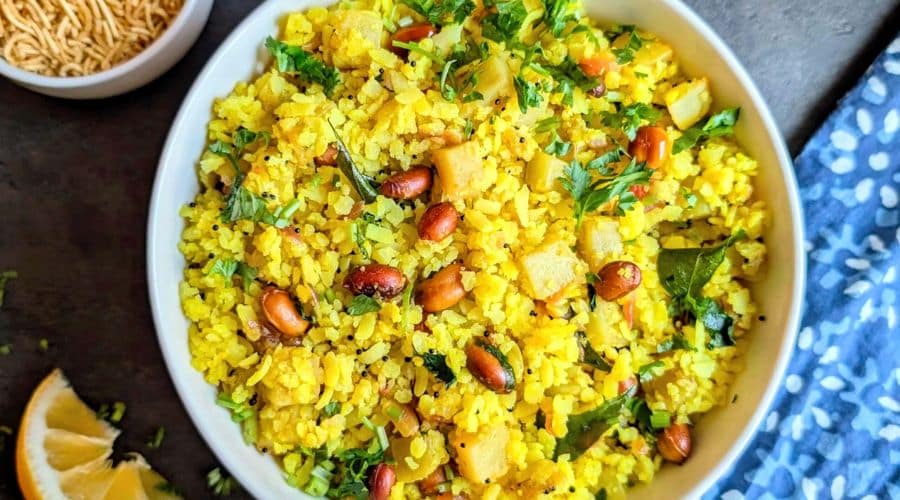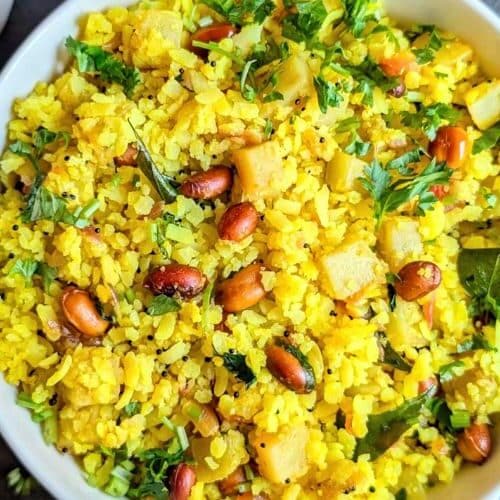Poha is a traditional Indian dish made from flattened rice, popular across the country, especially for breakfast or as a light snack.
Its simplicity and versatility make it a favorite in many households.
The dish holds cultural significance in several regions, especially in Maharashtra, Gujarat, and Madhya Pradesh, where it’s often served with various accompaniments, such as chutneys or yogurt.
Not only is Poha easy to prepare, but it also offers numerous health benefits.
Packed with carbohydrates, fiber, and essential vitamins, it is a nourishing meal choice that’s light yet satisfying.
With its mild, aromatic flavors and the addition of fresh herbs and spices, Poha can be enjoyed in countless variations to suit different tastes.

Ingredients Needed for Poha
To prepare a delicious and authentic Poha, the following ingredients are essential:
Main Ingredients:
- Flattened Rice (Poha): The star of the dish, it is easily available at most grocery stores. You can find it in thick, medium, or thin varieties, each offering a slightly different texture when cooked.
- Oil: For tempering the spices and sautéing the vegetables.
- Mustard Seeds: Adds a pungent flavor and aroma.
- Cumin Seeds: Imparts a warm, earthy taste to the dish.
- Turmeric Powder: Gives Poha its signature yellow color and a mild flavor.
- Green Chilies: For a subtle heat that balances the other flavors.
- Salt: Enhances the overall taste of the dish.
Vegetables (Optional):
- Onion: Chopped finely, onions give Poha a crisp texture and savory flavor.
- Potato: Optional but highly recommended for added heartiness.
- Peas: These bring sweetness and a pop of color to your Poha.
- Carrot: Adds crunch and a vibrant color.
Garnishing:
- Lemon Juice: For a zesty freshness.
- Coriander Leaves: Adds a bright, refreshing flavor.
- Peanuts or Cashews: For extra crunch and a nutty finish.
- Curry Leaves: Optional but they enhance the aroma.
Preparation of Poha
To begin making Poha, preparation is key to getting the texture just right. Here’s how to get everything ready before you start cooking:
Soaking the Poha:
- Take the flattened rice and rinse it thoroughly under cold water. If you’re using thick Poha, soak it for 5-7 minutes, ensuring it doesn’t become too soggy. If you’re using thin Poha, a quick rinse is sufficient. Gently fluff the Poha with your fingers after rinsing to separate the grains and avoid clumping.
Chopping Vegetables:
- While the Poha soaks, chop the vegetables you’ll be using. Dice the potatoes, onions, and carrots into small, uniform pieces. If using peas, you can either use fresh or frozen ones, and keep them ready for cooking.
Roasting Peanuts (Optional):
- In a small pan, dry roast the peanuts until they turn golden brown. This step adds a crispy, nutty texture that elevates the dish. You can skip this step if you prefer a lighter Poha or if peanuts are not available.
Cooking Poha – Step-by-Step Guide

Now that all your ingredients are prepped, it’s time to cook the Poha. Follow these simple steps to create a flavorful, perfectly cooked dish.
Step 1: Temper the Spices
- Heat 2 tablespoons of oil in a pan or wok over medium heat. Once the oil is hot, add 1 teaspoon of mustard seeds. Let them splutter for a few seconds before adding 1/2 teaspoon of cumin seeds. Stir to combine.
Step 2: Sauté Onions and Other Vegetables
- Add finely chopped onions and sauté until they turn soft and translucent. If you’re using potatoes, add them at this stage and cook until they become tender. You can cover the pan for a few minutes to speed up the cooking process. Once the potatoes soften, add peas, carrots, or any other vegetables you’re using.
Step 3: Add the Soaked Poha
- Once the vegetables are cooked, lower the heat and gently add the soaked Poha to the pan. Stir carefully, ensuring the Poha is evenly mixed with the spices and vegetables. Add turmeric powder, salt, and any other seasonings like sugar or chili powder as per your taste.
Step 4: Cook and Steam
- Let the Poha cook for about 5 minutes. If you find it too dry, you can sprinkle a little water to help it steam. Stir occasionally to prevent sticking. The goal is to keep the Poha moist but not soggy.
Step 5: Final Touches
- Turn off the heat and squeeze fresh lemon juice over the Poha. Garnish with roasted peanuts or cashews, fresh coriander leaves, and a few curry leaves for an aromatic touch.
Poha is now ready to be served! It’s best enjoyed hot, with a side of yogurt or chutney for extra flavor.
Tips and Tricks for Perfect Poha
To ensure your Poha turns out perfect every time, here are some essential tips and tricks to keep in mind:
1. Avoid Over-Soaking the Poha
- Soaking Poha for too long can lead to a soggy texture. If you use thick Poha, soak it for 5-7 minutes, and for thinner varieties, just a quick rinse is enough. Always check the texture by gently pressing a grain between your fingers before cooking.
2. Keep the Heat Low While Cooking
- Cooking Poha on high heat can lead to uneven cooking and might cause it to stick to the pan. Always use medium or low heat when mixing the Poha with spices and vegetables to maintain its delicate texture.
3. Add Moisture Sparingly
- If your Poha feels dry after mixing, sprinkle just a little water to allow it to steam and soften. But be careful not to add too much water, as it can make the dish soggy.
4. Fluff the Poha Gently
- After rinsing, fluff the Poha gently with your fingers to separate the grains. This will prevent the Poha from clumping together while cooking.
5. Taste and Adjust Seasonings
- Poha is all about balance. Always taste your dish before serving and adjust the seasonings accordingly—whether that means adding more salt, sugar, or a little extra lemon juice for tanginess.
6. Garnish for Extra Flavor
- Garnishing Poha with fresh coriander, roasted peanuts, or a sprinkle of sev can elevate its flavor and texture. Don’t skip this step, as it adds a delightful crunch and freshness to the dish.
Health Benefits of Poha
Poha is not just a tasty dish but also a healthy choice for those looking to maintain a balanced diet. Here are some of the key health benefits:
1. Rich in Carbohydrates
- Poha is an excellent source of carbohydrates, providing the body with a steady supply of energy throughout the day. It is ideal for breakfast as it keeps you energized and alert without making you feel sluggish.
2. Easy to Digest
- Flattened rice is easy on the stomach, making Poha a great choice for people with sensitive digestion or those recovering from illness. The low fiber content of Poha ensures that it’s light but filling.
3. High in Fiber
- When prepared with vegetables such as peas, carrots, and potatoes, Poha becomes a good source of dietary fiber. Fiber helps promote healthy digestion and can contribute to managing cholesterol levels.
4. A Source of Essential Nutrients
- Poha provides a good amount of iron, especially when paired with ingredients like peanuts, which are rich in this vital mineral. Iron is important for preventing anemia and maintaining healthy blood circulation.
5. Supports Weight Management
- Because Poha is light and low in calories, it makes for a filling yet low-fat meal, which can help with weight management when consumed in moderation. Adding vegetables and nuts can further enhance its nutritional value without overloading on calories.
6. Gluten-Free
- Poha is naturally gluten-free, making it a great alternative for those with gluten sensitivity or celiac disease. It offers a safe and tasty meal option without compromising on flavor or texture.
Poha is a great example of a meal that’s not only delicious but also packed with health benefits, making it a wonderful addition to any diet.
Conclusion
Poha is a simple, nutritious, and versatile dish that brings together the best of comfort food and health-conscious eating.
Whether you enjoy it as a hearty breakfast, a light lunch, or a satisfying snack, Poha offers endless possibilities for customization with vegetables, nuts, and spices.
Its ease of preparation, combined with its rich history and cultural significance, makes it a beloved dish in many households.
By following the tips and tricks provided, you can ensure that your Poha comes out perfect every time, offering the ideal balance of flavor and texture.
The health benefits—from its rich carbohydrate content to its digestive-friendly qualities—further solidify Poha as a great choice for anyone looking for a nourishing meal.
So, next time you’re in the mood for something quick, healthy, and tasty, consider making Poha.
It’s a dish that will leave you satisfied and energized, all while connecting you to a rich culinary tradition.
Frequently Asked Questions (FAQs)
1. How long can I store leftover Poha?
- Leftover Poha can be stored in an airtight container in the refrigerator for up to 1-2 days. To reheat, sprinkle a little water and heat it on a pan, stirring occasionally to prevent it from drying out.
2. Can I make Poha without onions or other ingredients?
- Yes, Poha is highly customizable. You can skip the onions or any other ingredients based on your preference or dietary restrictions. The core of Poha is the flattened rice, and it can still be flavorful with just the basic spices and vegetables.
3. Is Poha gluten-free?
- Yes, Poha is naturally gluten-free, making it a suitable option for people with gluten intolerance or celiac disease. However, always check the packaging for any cross-contamination if you’re highly sensitive.
4. Can I add other vegetables to Poha?
- Absolutely! You can add a variety of vegetables like bell peppers, tomatoes, or spinach to your Poha, depending on what’s available or your personal taste preferences. The more colorful, the better!
5. How do I make Poha spicier?
- If you prefer a spicier Poha, you can add more green chilies, chili powder, or even a pinch of red chili flakes while cooking. Adjust the spice level to suit your taste, and enjoy a hotter version of this dish!

Poha
Equipment
- 1 large pan or wok (for cooking Poha)
- 1 small bowl (for soaking Poha)
- 1 small pan (for roasting peanuts, optional)
- 1 Knife (for chopping vegetables)
- 1 chopping board (for chopping vegetables)
- 1 Spoon (For stirring)
Ingredients
- 2 cups Flattened rice Poha
- 1 tablespoon Oil
- 1 teaspoon Mustard seeds
- 1/2 teaspoon Cumin seeds
- 1/2 teaspoon Turmeric powder
- 1-2 Green chilies sliced
- 1 medium Onion finely chopped
- 1 small Potato peeled and diced
- 1/4 cup Peas fresh or frozen
- 1/4 cup Carrot grated or finely chopped, optional
- 1/4 cup Roasted peanuts or cashews optional
- 1 tablespoon Lemon juice
- 1/4 cup Fresh coriander leaves chopped, for garnish
- Salt to taste
- Sugar optional, to taste
Instructions
- Rinse the Poha: Place the flattened rice (Poha) in a large bowl and rinse it under cold water. If using thick Poha, soak for about 5-7 minutes; for thinner varieties, a quick rinse is sufficient. Gently fluff with your fingers to separate the grains.
- Prepare the Vegetables: While the Poha is soaking, chop the onion, dice the potato, grate the carrot, and prepare any other vegetables you plan to use.
- Roast the Peanuts (Optional): In a small pan, dry roast the peanuts until golden brown. Set aside.
- Temper the Spices: Heat 1 tablespoon of oil in a large pan over medium heat. Add mustard seeds and let them splutter. Then, add cumin seeds and sauté for a few seconds.
- Cook the Vegetables: Add the chopped onions and sauté until translucent. Add the diced potatoes and cook until tender, about 5-7 minutes. If using carrots and peas, add them now and cook for another 3 minutes.
- Combine the Poha: Lower the heat and add the soaked Poha to the pan. Stir gently to combine with the vegetables and spices. Sprinkle turmeric powder, salt, and a pinch of sugar (if using). Mix well, ensuring the Poha is evenly coated with spices.
- Steam the Poha: Cover the pan and cook for 5 minutes on low heat to allow the Poha to steam and absorb the flavors.
- Final Touches: Turn off the heat and squeeze lemon juice over the Poha. Garnish with roasted peanuts or cashews and freshly chopped coriander leaves.
- Serve: Serve hot with a side of yogurt, chutney, or enjoy it on its own!
Notes
- Customization: You can add any vegetables you like, such as bell peppers, tomatoes, or spinach, to enhance the flavor and texture of your Poha.
- Vegan Option: This recipe is naturally vegan, but you can skip the peanuts if you have allergies and substitute with other nuts or seeds for crunch.
- Storage: Leftover Poha can be stored in an airtight container in the refrigerator for 1-2 days. Reheat with a little water to retain moisture.
- Spice Level: Adjust the spice level according to your preference by adding more or fewer green chilies.

